The Character of Cricket Read online
Page 6
During the war Mr Deakins served with the Navy, mainly at Scapa Flow. When he returned, and was promoted to succeed R. V. Ryder, he found that he had an unusually go-ahead and also rich new president: Doctor Thwaite, now immortalised by ‘The Thwaite Gates’ and ‘The Thwaite Scoreboard’. ‘I want,’ Thwaite told him, ‘to be president, but president of what? I want to be president of something worth being president of.’ Thwaite had two specific ambitions. He wanted a side that could emulate the 1911 Warwickshire team and win the championship. And he wanted a ground which would once again stage Test matches. It is a matter of record that in 1951 Warwickshire were county champions and that in 1957 they started to stage Test matches again.
The team building was helped by having Tom Dollery as captain. Dollery had been at Edgbaston since 1934 and was one of the most astute leaders of his time. Otherwise the nucleus was small. Mr Deakins says that he personally scoured the most obvious nursery – the Minor Counties – and recruited men like Dick Spooner and Alan Townsend from as far afield as Durham, Berkshire and Cornwall. The improvements to the ground were made possible by a phenomenally successful football pool scheme. The idea had been pioneered by the Roman Catholic Church, and in the cricket world by Worcester. The Warwickshire authorities went to Worcester, learned how the scheme worked and adapted it with such success that they built up to 10,000 agents and cleared £180,000 a year.
Mr Deakins played a prominent part in all this and he remains a regular visitor to the ground as well as running the old county cricketers’ association which exists ‘to bring together both in season and out of season in good fellowship and in the true spirit and tradition of cricket those who have played first-class county cricket for Warwickshire.’ The Deakins view is not always orthodox, but is almost always robust.
He regrets, for instance, the passing of the amateur and says that the legislation which abolished the distinction between ‘gentlemen’ and ‘players’ in 1962 represented the single most significant change in the game in his lifetime. But he defends one-day cricket. He thinks the successful players in the one-day game play just as ‘correctly’ as their predecessors; and for many people the three-day game was a disaster. ‘I can recall people coming to me and saying “You won the toss and batted, and all I saw on Saturday was Jack Hobbs or Frank Woolley fielding.” They didn’t like that.’ They liked it even less when they had to go to work on Monday and Hobbs or Woolley played a classic innings.
Mr Deakins is also good on committees. ‘A body of the unfit elected by the unwilling to do the unnecessary,’ he says – while making it clear he is not talking about his own county’s committee. Then, in the next breath, he asked if I knew the classic definition of a committee, which I didn’t. ‘A committee is like a bunch of bananas,’ he explained, ‘– they start green, turn yellow and in the end there isn’t a straight one in the bunch.’
Critics of change have complained that Edgbaston has become ‘a concrete mausoleum’. Mr Deakins nods in part agreement and says that would be inappropriate at Worcester or Taunton, but here in Birmingham....
The huge executive suite to the left of the pavilion as you look towards the city is the most obvious example of the ‘concrete mausoleum’ approach. It is a long way from thatched roof and roses over the door of the pub, but it works. One hundred companies pay an £800 annual membership which entitles them to eight admissions on any day. Even during the Zimbabwe game sixty lunches had been booked. When I wandered in, businessmen and their clients waited in salivating queues for cuts off various joints. ‘We have two ballrooms here,’ said Alan Smith laconically, and I wasn’t entirely sure whether he approved or not. Ordinary members of the Warwickshire club use the bar and restaurant below. It has just as good a view but is not quite so luxurious. Stewards do occasionally have trouble with non-Executive Club members climbing in over the railings from below and ordering drinks on other people’s accounts. Not cricket.
The stands are large and glassy, and not particularly beautiful, but there is a lot of leafiness about, and the astute club owns twenty-odd acres all round, so no high-rise blocks shut out the light and you can see the towers of Brum away in the distance. I feel about this place that it is a not wholly resolved compromise between town and country, trade and aristocracy, progress and conservatism. On the walls of the club room the photographs of the 7th Earl of Warwick (by Vivienne of London) and Brigadier Sir Richard Anstruther-Gough-Calthorpe share space with Dr Thwaite and Mr Ludford C. Docker. Edgbaston displays a charmingly idealist poem from Haverford, near Philadelphia, full of cricketing references like ‘the last over which we all must face’ and ‘the captain who has gone before’.
Could you imagine this whole earth could yield
A spot more beautiful than our old cricket field?
I prefer the pithier reality of the original rules of the old Birmingham Club, especially the one which says: ‘A member beginning a game and not remaining to the end shall forfeit sixpence.’
P.G. Wodehouse could have built a lovely short story from that, with Percy Jeeves bowling from in front of the pavilion and Bertie Wooster forfeiting a sixpence for not remaining to the end. I wonder what happened to the old boy’s Warwickshire tie? It’s not in the glass case.
The Sixth Form Ground, Harrow
There are two Harrows. One is the John Betjeman Harrow, far out on the Metropolitan line, a land of semi-detached houses built by a giant with a set of Minibrix, the Lego of the forties and fifties. Here and there is an Italian restaurant with music on Friday and Saturday nights and all roads lead to Wembley stadium. The vivid yellow signs of the AA are stuck to every lamp-post.
In the middle of this Metroland there is an island. It would be too fanciful to call it Camelot, but it has something of St Michael’s Mount about it as you look out from the window of the northbound train just before Harrow and Wealdstone station. It is steep-sided with narrow streets, a mish-mash of private houses of all periods, some impressive, rather monumental public buildings and a tall church steeple to crown it. This English hill-village is the other Harrow: the Harrow which educated Byron and Palmerston and Baldwin and Churchill; the Harrow of ‘Eton and Harrow’, as evocative and inescapable a combination as Fortnum and Mason or Bubble and Squeak.
Even the graffiti at the bottom of the hill seemed Harrovian. ‘Happy birthday debs’ said the one on the left (referring, I hoped, to debutantes rather than Deborah), while the one on the right said ‘Ahoy Anybody?’
In fact I approached the wrong way. The green emptiness at the foot of that side of the hill is for rugger. The cricket is played at the foot of the other side. Always has been, Harrovians tell you, though the school was founded in 1571 and serious cricket did not start until over two hundred years later.
The Eleven was playing Haileybury and having much the better of it. The Haileybury coach said ‘Reg’s Carefree Holiday Tours’ on the back, which did not strike me as altogether propitious. Harrow had put them in on a dampish day and skittled them out for 83. Harrow’s opening batsmen looked comfortable. It had been a good toss to win, but in any case Harrow were a strong side. They had already beaten the old boys by ten wickets and MCC by five. As for schools, they had squeaked home by one wicket against Radley, but comfortably disposed of St Edwards, Oxford (98 runs), Winchester (seven wickets), Malvern (five wickets) and Charterhouse (an innings and 108 runs). Only Eton were left.
Like a county ground, Harrow’s ‘Sixth Form Ground’ has impressive gates, dedicated in this case to ‘M.C. Kemp, 1861-1951, Master in charge of cricket for thirty-three years.’ The inscription goes on to say that the ‘wide extension’ of the playing fields was due to his ‘energy and foresight’. But there is an even more impressive plaque a little further up the drive. It is on the wall of the Old Harrovian Field House Club and it says: ‘Whereas by an Act passed in the reign of His Majesty George III this piece of ground was allotted to the Governors of Harrow School for a Place of Exercise for the Scholars and provision ordered that no road
or Highway should be made, maintained or supported in, over or through the same.’
It is quirkily predictable that Harrow should have a cricket ground protected by a Georgian Act of Parliament. In the same way I was not wholly surprised to learn that their first two cricket professionals were Wilfred Rhodes and Patsy Hendren. The present holder of that title is Percy Davis, a twinkling septuagenarian, resplendent in his Northants sweater and Northants blazer and Oxford and Bucks Light Infantry tie. I found him by the nets, talking to the master in charge of cricket, Bill Snowden, who played in Majid Khan’s Cambridge University team. These two and Peter Ward, the groundsman, who started work at the school forty-seven years ago, make up the key triumvirate in modern Harrow cricket. Peter Ward succeeded his father, who also had forty-seven years in the job.
It was he who took me over to the Harrow Field House Club. The crowd was sparse – a local or two stood on the pavement and leaned reflectively on the fence; a few boys and masters; a very occasional parent, and one family group finishing a picnic at a table laid with a white cloth. They had bottles of red and white wine, and although I didn’t wish to pry it didn’t look as if it came from Tesco. Nor did I eavesdrop, but I couldn’t help catching ‘... and found he had to educate six children out of earned income. And that isn’t easy.’ Strange how a throw-away reminder of the cost of certain things brings out the socialist in one.
The club is part dressing-room for visiting teams, part viewing platform and drinking den (good bar) for Old Harrovians, and part museum. The old photographs, the bats, the scorecards, the relics are as impressive as most counties’. The single most extraordinary revelation for me was that A.C. MacLaren of Lancashire and England and F.S. Jackson of Yorkshire and England both played in the same Harrow School eleven just under a hundred years ago. A similar contemporary coincidence is unthinkable. The Harrow triumvirate could only think of two current first-class cricketers from Eton and Harrow:
Barclay and Pigott. A.N. Hornby (‘O my Hornby and my Barlow’) was a Harrovian; and so were Robin Marlar and Aidan Crawley, once a Labour and then a Conservative MP who made 156 out of 257 for Kent against Essex – an innings described by Lord Harris, who was watching, as ‘the most remarkable ever played’. Charabanc loads of Crawleys have been to Harrow, all of them apparently cricketers. A Crawley XI played Lords and Commons on 1 June 1965. Viscount Monckton was in the 1910 Lords team along with the future Field Marshal Alexander of Tunis. How debonair he looks in his photograph. The Earl of Bessborough and The Hon. R. Grimston played in ’84 and founded I Zingari later. There is a Spy cartoon of Bessborough hanging in the Field House Club, and nearby they have Bessborough’s umbrella, very ramshackle and ill-furled, just as it is in the picture. My housemaster, whose father was headmaster and who married his housemaster’s daughter, played during the war. P.C. Boissier. 1941.
Best of all is a huge oil painting entitled The Interval, 1905. It was discovered in a garage in Orpington, and shows the crowd outside the Lord’s pavilion in presumably the lunch or tea break during the Eton and Harrow match. Hundreds of toffs in toppers with frilled ladies. You catch a real sense of a past world from it – even though as a painting it is not particularly good. That was a time, you feel, when the nation’s business – whether in Parliament or the City or the law courts – adjourned for the day, and the great and the good went off to watch their old schools play cricket. I did not check to see if Stanley Baldwin, then the adopted Tory candidate for Kidderminster, was present. Baldwin’s biographer says that of his contemporaries at the school four became viceroys, ten bishops, twelve colonial governors, a dozen ambassadors, seventeen judges, thirty-three privy councillors and sixty-four generals. Looking at that painting of the 1905 game, you can well believe it.
If Harrow’s place in the world has slipped in recent years, the cricket at least is holding up. Peter Ward likes to prepare true wickets. ‘You can’t have the ball flying about. I want them to be able to play off the front foot.’ And Percy Davis instils the basics to such effect that since he arrived the record in that all-important Eton match is three-two in his favour. And there have been moral victories too. He says he cried after one game. Harrow declared with only two wickets down and bowled Eton out. Harrow went in again and once more declared after losing only two wickets. Eton got the runs with two wickets left. Percy still can’t believe it. ‘They lost eighteen wickets. We lost four. And they won.’
On another occasion, when the Lord’s wicket was being dug up in order to get rid of the infamous ridge, Eton played on the Harrow Sixth Form Ground and managed to get them all out by bowling, Percy Davis alleges, about forty overs an hour. John Barclay, the Eton captain, now of Sussex, almost completely dispensed with his run-up.
Percy was heartbroken. But the ’85 side was a good one, with a terrific pair of fast bowlers called Pethers and Fox. Even Percy Davis, who made his first fifty against Larwood and Voce in 1933, spoke highly of Pethers and Fox.
We had tea in the professionals’ room at the back of the pavilion. Bill Snowden, Percy Davis, the umpires, a couple of stiff-upper-lipped Haileybury beaks (Harrow got the runs with only two wickets down) and a lady artist who specialises in painting cricket grounds. There were old caps, striped and quartered and hooped, hanging on pegs along with Percy’s own maroon Northants one, and we had sandwiches and cup cakes and milky tea from a huge tin pot. Each year, agreed Bill and Percy and the Haileybury beaks, they see boys who should go on to first-class cricket. Percy Davis said he had had one the other year, Matthew Fosh, who should have captained England, but he gave up cricket after a few games for Essex and rode a horse round Canada. Or something like that.
Nowadays Harrovians have to earn a living – especially if they’re educating their young out of earned income. And you can’t pay Harrow fees from an average county player’s salary. But that doesn’t mean the Harrow standard has dropped. Next week I Zingari. Then Eton and Lord’s. ‘It’s my seventieth year,’ said Percy, ‘and the 150th of the match. If we can pull that off I’ll be happy. It’s what I live for.’
Horris Hill
Prep school cricket is like village cricket – in terms of skill it comes very low in the scale of things. In every other respect it is the best possible cricket. The setting is nearly always rural and wooded, with a small pavilion probably presented by a rich parent; the wicket will have been prepared properly by the school groundsman, supervised by the headmaster, who will almost certainly be a decent club cricketer who just missed a Blue; the game will be short and to the point and highly competitive; and the team teas will include sticky buns.
I would have written about my old school’s ground in the lea of the Quantocks five miles west of Taunton. Before the school was evacuated there from Weymouth during the war it had belonged to the Boles family. Boles baronets held cricket weekends in the twenties and thirties. Robertson-Glasgow played. The pavilion was thatched.
Anyhow I can’t write about that prep school ground because it is now the home of the Bishop’s Lydeard village team. Instead I paid a visit to Horris Hill.
Horris Hill is a Victorian foundation a few miles south of Newbury, and just off the Winchester road. Partly because of Horris Hill’s geographical proximity to Winchester, the school’s stock in trade is preparing boys for the Winchester College entrance and scholarship exams. Malcolm Innes, the headmaster, gave me a list of the Horris Hill exam results for the seven years between September 1978 and July 1985. It is a fairly stunning document. ‘Winchester Entrance: 48 boys took the examination and they all passed.’ Seven boys won Winchester scholarships; three got exhibitions. Fifty-four of their boys passed into Eton, and of 138 who took the common entrance only three failed to get into the school of their choice. A note at the bottom of this catalogue says rather austerely, ‘Horris Hill has no entrance examination at present. Sometimes, however, boys come to Horris Hill who might be better suited at a school where remedial help is part of the normal curriculum. In such cases parents are advised of the s
ituation but in no case does Horris Hill insist on a boy’s removal to another school.’
For many years Horris Hill was a family business, run by the Stows. Mr Innes filled me in on the school’s academic background but preferred to leave it to the two surviving Stows, Jimmy and Sandy, to tell me about cricket and about history. They still live near the school which they used to run and when they came into the present headmaster’s drawing-room I found myself irresistibly reminded of my own prep school days. Tweedy and beaming, amusing and amused, they seemed the epitome of the prep school master. A breed quite unlike ‘public school master’ or ‘state school master’, being quirkier, more relaxed, less harassed. I think it is because when their little charges leave at the age of thirteen all their futures seem so rosy. It is only later that the doubts start to seep in. I wonder whether there isn’t more optimism in a prep school than anywhere else in life. Or, if you’re being hostile, more smugness. Two sides, I suppose, of the same coin.
‘Our dear father,’ they said, ‘was a cricketer, and Horris Hill did cricket and classics and very little else. There were no frills at all.’
The most famous Horris Hill cricketer was D.R. Jardine himself, and Jardine captained the school in one of the most famous or infamous matches in prep school cricket history. It was one of the few occasions on which both schools were led by future captains of England. The opposition was Summer Fields, of Oxford, captained by G.O.B. Allen. Summer Fields was an Eton prep, and rivalry between the two places was – and still remains – intense. That year – 1914 – Summer Fields were unbeaten but it was generally acknowledged that Horris Hill were much the stronger side.
The Summer Fields cricket master, Mr Alington, therefore decided that his side would bat first and stonewall. The usual convention in prep school cricket was that the side batting first should, if not all out, then declare sportingly enough to allow the opposition at least a notional chance of getting the runs. Mr Alington was enough of a realist to know that if he did that Horris Hill would get the runs.

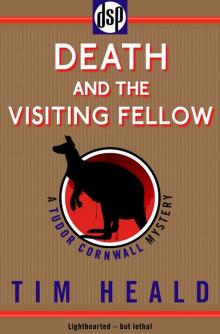 Death and the Visiting Fellow
Death and the Visiting Fellow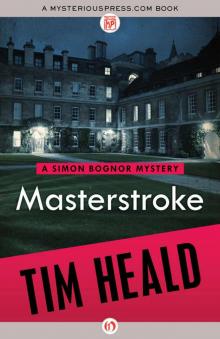 Masterstroke (The Simon Bognor Mysteries)
Masterstroke (The Simon Bognor Mysteries) Deadline (The Simon Bognor Mysteries)
Deadline (The Simon Bognor Mysteries)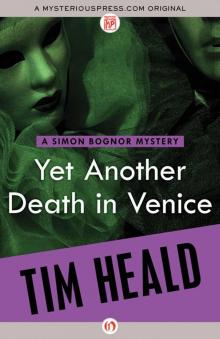 Yet Another Death in Venice (The Simon Bognor Mysteries)
Yet Another Death in Venice (The Simon Bognor Mysteries)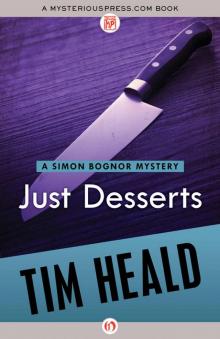 Just Desserts (The Simon Bognor Mysteries)
Just Desserts (The Simon Bognor Mysteries)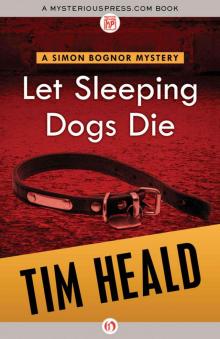 Let Sleeping Dogs Die (The Simon Bognor Mysteries)
Let Sleeping Dogs Die (The Simon Bognor Mysteries)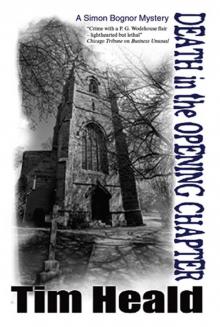 Death in the Opening Chapter
Death in the Opening Chapter Blue Blood Will Out (The Simon Bognor Mysteries)
Blue Blood Will Out (The Simon Bognor Mysteries)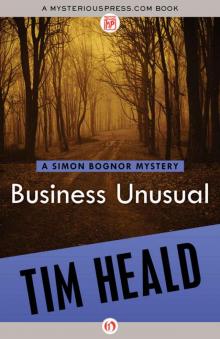 Business Unusual (The Simon Bognor Mysteries)
Business Unusual (The Simon Bognor Mysteries)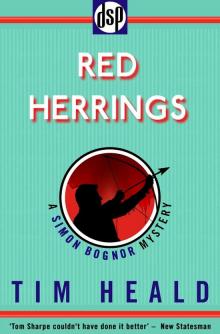 Red Herrings
Red Herrings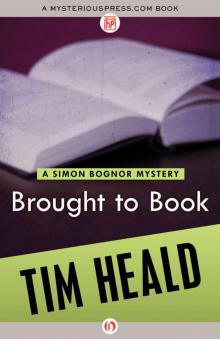 Brought to Book (The Simon Bognor Mysteries)
Brought to Book (The Simon Bognor Mysteries)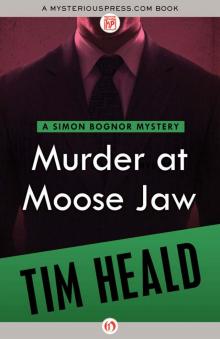 Murder at Moose Jaw (The Simon Bognor Mysteries)
Murder at Moose Jaw (The Simon Bognor Mysteries)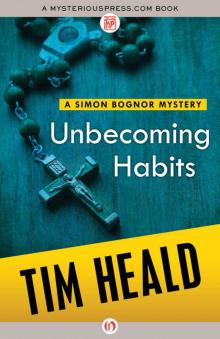 Unbecoming Habits (The Simon Bognor Mysteries Book 1)
Unbecoming Habits (The Simon Bognor Mysteries Book 1)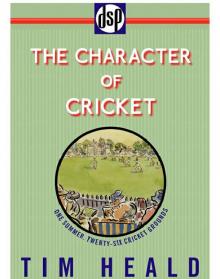 The Character of Cricket
The Character of Cricket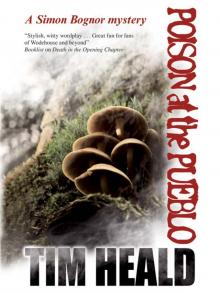 Poison At The Pueblo
Poison At The Pueblo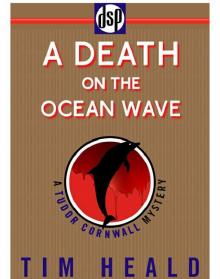 A Death on the Ocean Wave
A Death on the Ocean Wave